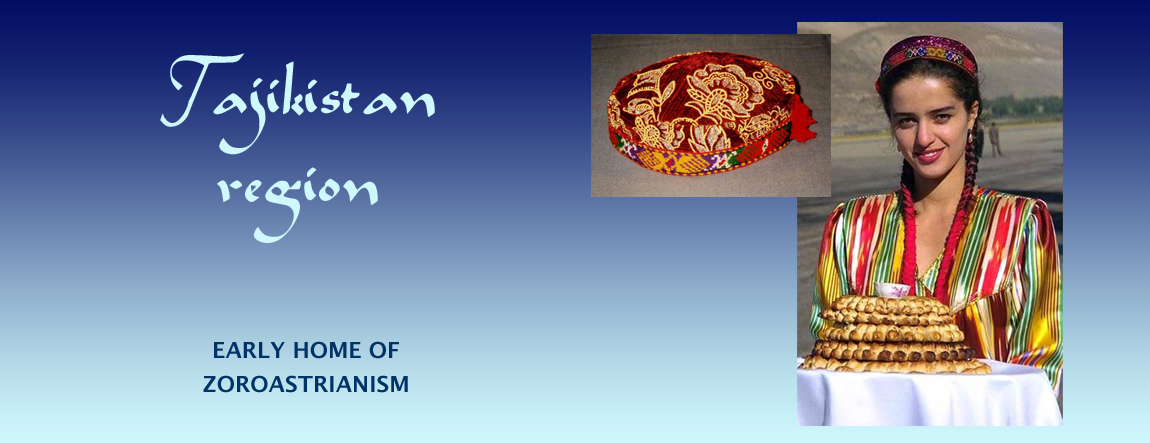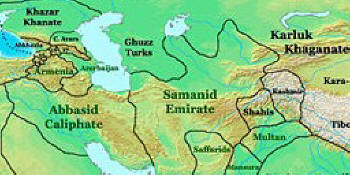
Image credit: Pamir.org
Contents

Tajikistan Region
Page 1
Tajikistan Region & Zoroastrianism
Page 2
Sugd / Sogdiana
Page 3
Pamirs
Page 4
Pamiri Houses & Zoroastrian Symbols
Page 5
Pamiri Zoroastrian Historical Sites
Page 6
History
Early Tajikistan History
While the Tajiks are passionate about their Aryan heritage and aware of their Zoroastrian roots, they do not have a sense of their early history and it is not until the rise of the Samanid dynasty in the ninth century ACE, that the Tajiks gained a sense national identity. Even their name as a group is relatively modern.
Airyana Vaeja, the land of the Aryans, the birthplace of Zarathushtra and Zoroastrianism could very well have been located in the environs of Tajikistan. The Amu Darya river, called Panj in Tajikistan, today forms the southern border between Tajikistan and Afghanistan. The river (probably the northern reaches that borders Uzbekistan) is mentioned in texts as being on the boundary between Turan and the Iran of old. There are other striking clues that point to this possibilities. (See the page on Aryans.)
Various text state that Tajikistan was originally part of the Bactrian kingdom - the Bakhdi of the Zoroastrian Avesta. Bakhdi in turn, was later a part of the greater Iranian nation.
Airyana Vaeja itself disappeared from history only to re-emerge as Iran - the name of the country ruled by the Persian Sassanian kings in 226 ACE. It is also possible that the original Aryan lands were abandoned by the Aryans because of extreme climate changes or because of invasions. Tajikistan, being on the frontiers between the Indo-Iranian nations and the Turkomans, has constantly been subject to domination by invading armies. It is also known to experience severe cold spells.
Oxus Treasure at the British Museum
Items related to the Oxus Treasure at the British Museum
Samanid Dynasty 819-1005 ACE

|
| Samanid Territory |
The Samanid dynasty was founded after the collapse of the Persian Sassanid dynasty. The dynasty was named after its founder Saman Khuda, a Iranian Tajik, who was a member of the Zoroastrian theocratic nobility with roots in the city of Balkh. Saman Khuda converted to Sunni Islam.
The initial territory governed by Saman Khoda was small. During the reign of Saman-Khuda’s great-grandson, Ismail I (892–907 ACE), Samanid territory expanded considerably. In 900, Ismail defeated the Saffarids in Khorasan. Ismail's brother was the governor of Transitional at that time. The highest peak in Tajikistan is named Peak Ismail Samani.
While the Samanids allied themselves with the Abbasid dynasty that ruled Iran, they were the first Iranian dynasty to rule after the Arab conquest of Iran. They declared that declared that "here, in this region, the language is Persian, and the kings of this realm are Persian kings." Their capital was Bokhara.
Samanid rule lasted for 180 years. At its greatest extent Samanid territory included Khorasan, Ray, Transoxiania, Tabaristan, Kerman, Gorgan, and the area west of these provinces up to Isfahan. To legitimize the dynasty, the Samanids claimed to be descendants of Bahram Chobin, and therefore descended from the House of Mihran, one of the Seven Great Houses of Iran.
» Top
The Emergence of the Tajik Nation
From 1924 to 1929, Tajikistan was part of the Soviet republic of Uzbekistan as the Tajik Autonomous Soviet Socialist Republic. Some soviets championed the cause of an separate Tajik republic, a cause that was resisted by the Uzbeks. A report was commissioned and in 1929 the Tajik Soviet Socialist Republic was made a separate constituent republic. However, the predominantly ethnic Tajik cities of Samarkand and Bukhara remained in the Uzbek SSR. The 1929 report to the Commission in Charge of Resolving the Land Dispute between Tajikistan and Uzbekistan by Nissar Muhammadov provides interesting information, and perhaps clues to older disputes say between the ancient Aryans and Turan and later between the Iranians and the Turkoman. The following are some extracts:
"As is evident, they (Tajiks) are the heirs to the most ancient Aryan culture of Asia related to the Iranian groups of the great Aryan tribes. As a result of their many misfortunes they have deposited their material remains in many places on the Iranian plateau. Even if the Aryan population of all these places were eliminated, the remainder of its inhabitants inform us of the great civilization which had spread far and wide, away from the present center of the Tajiks. We observe a clear indication of this in the (Tajikistan) Republic and in the former Turkistan region (Uzbekistan, Turkmenistan, Kyrgyzstan, Karakyrgyzstan, and Karakalpakistan). There is a great archaeological treasure in this land yet to be unearthed and studied. Present-day Tajikistan encompasses only a portion of the Central Asian archaeological remains of the Tajiks' past. Since this is a part of the whole under the present conditions of the nation, it would be impossible to study it without extending the studies to encompass the neighbouring republics."
"To summarize, the Tajiks are the most ancient peoples of Central Asia. Even after the invasion of the foreigners, which eliminated the Iranian element or otherwise tried to assimilate it into itself in a large region, or forced it to flee to the mountains, the Tajiks survived and still occupy a considerable tract of land in Central Asia. The northern settlements of the Tajiks are in the region of the Chatqal River (headwaters of the Chatqal River are in the Tashkent district). Biskon at 42š is the northern-most Tajik settlement of that time. About half a degree south, on the slopes of the same mountain system, the northern-most settlements remain in Ferghana surrounded by Turks as well as the not-so-large groups of Tajiks of the Tashkent district. In the eastern-most region of Tajik lands, which has separated itself from the body and gone ahead somewhat, are the independent villages on the slopes of the Himalayan mountains where these mountains join their eastern companions. Defining the spread of the Tajiks south is somewhat more difficult. The land inhabited exclusively by the Tajiks is in the south of the Turkistan mountains and the neighbouring Altai mountain to the headwaters of the Amu River (Panj River) and in other areas in Afghanistan and eastern Badakhshan which include the northern slopes of the Hindu Kush and its valleys."
"As mentioned above, the Tajiks are the oldest inhabitants of Central Asia. At some point, the Iranian element, known in Central Asia as the Tajiks, controlled this region along with northern Afghanistan, the Caspian region, Khwarazm, the regions of Bukhara, the east and west of the so-called Chinese Turkistan, and the Iranian plateau. The culture of the Tajiks' ancestors played a major role in the world as testified to by Laufer who said, "We know that at some point the Iranian peoples occupied limitless lands which included Chinese Turkistan through which they had established trade, especially with the Chinese and the Turks. The Iranians were the great middlemen connecting the West to the East. They brought the heritage of the Greeks to Central Asia and the East and carried the plants and objects of art from China to the Mediterranean. Their activities had historical and world-wide significance to a degree that without access to Chinese documents we would not be able to write the true history of this period.
"The wave of attacks and their subsequent resettlement in Central Asia adversely affected the Iranians, forcing them to either assimilate into the invaders or flee into the highlands for protection. These were places that, unlike the river valleys, were not desired by the invaders.
"The very reason that present-day Tajiks' occupy the most difficult terrain, away from the good pastures, is that their best lands and most profitable occupations had been usurped by the invaders. That which remains continues to be desired by the same invaders."
» Top
Tajikistan Pages:
» Page 1 Tajikistan Introduction)
» Page 2 (Turan & Sugd - Sogdiana)
» Page 3 (Pamirs, page 1, Introduction)
» Page 4 (Pamirs, page 2, Pamiri Houses)
» Page 5 (Pamirs, page 3, Pamiri Historical Sites)